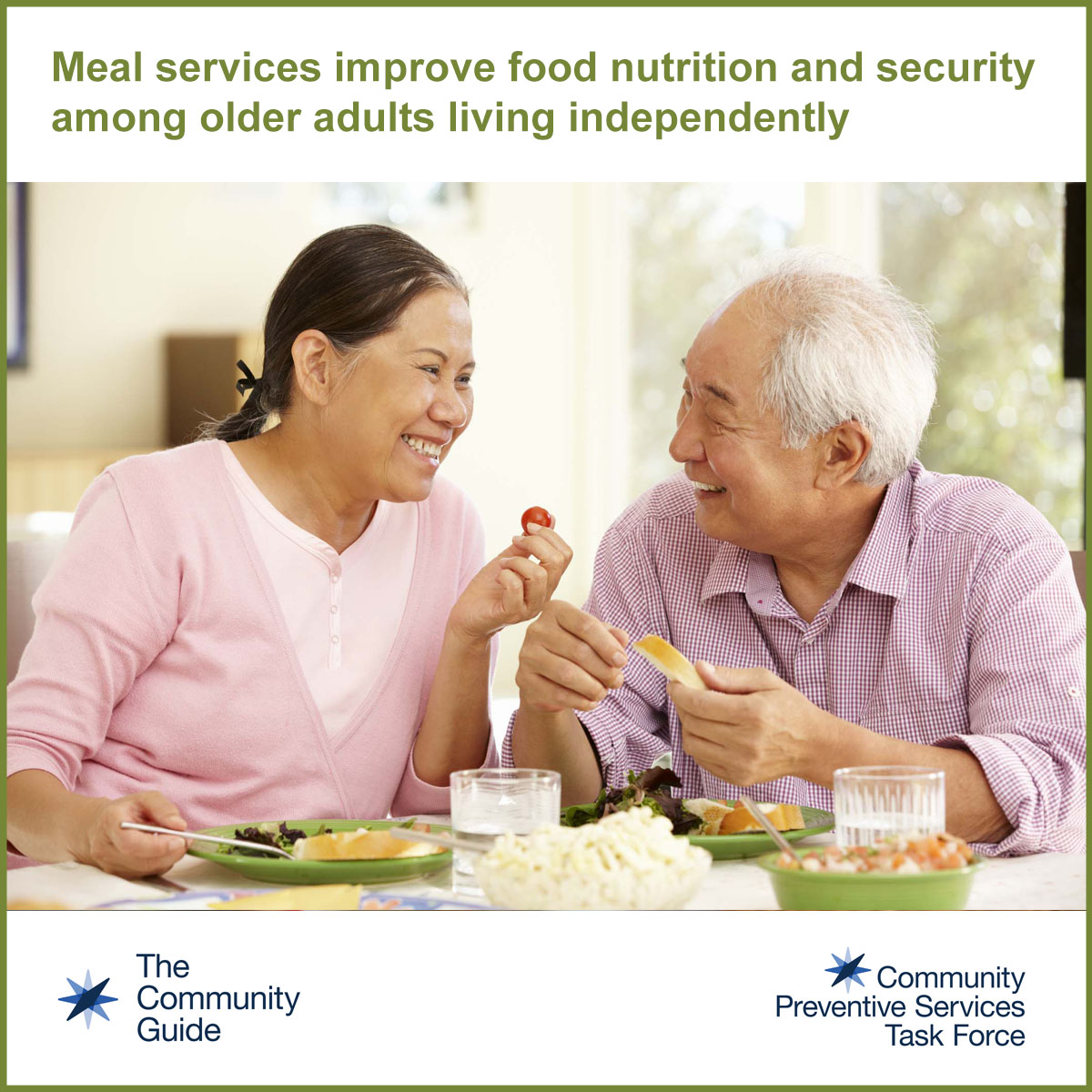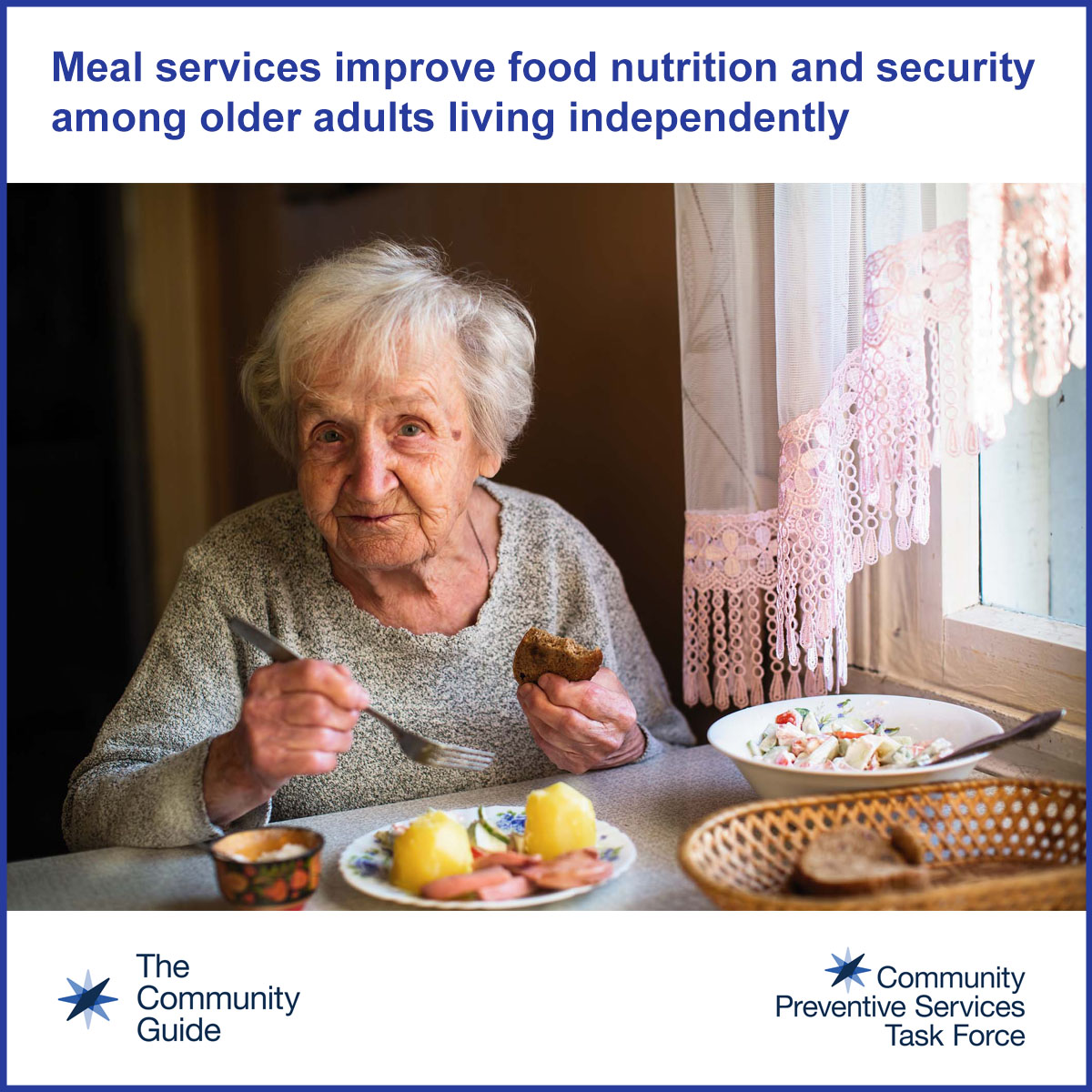Nutrition: Home-delivered and Congregate Meal Services for Older Adults
Summary of CPSTF Finding
Intervention
- Home-delivered meal services, or
- Congregate meal services provided in group settings, such as senior centers, that give older adults an opportunity to socialize.
Meals typically follow nutritional guidelines, are usually provided five days per week, and may follow cultural- or health-related needs, such as diabetic requirements.
CPSTF Finding and Rationale Statement
Promotional Materials
One Pager
Graphics for Social Media


Please visit our social media messages and graphics page for full sized images and suggested social media messages.
About The Systematic Review
The systematic review was conducted on behalf of the CPSTF by a team of specialists in systematic review methods, and in research, practice, and policy related to nutrition.
Context
The Older Americans Act Nutrition Programs address these needs by providing home-delivered meal and congregate meal services to reduce hunger, food insecurity and malnutrition; enhance socialization; and promote health and well-being among older Americans (U.S. Department of Health and Human Services, 2021). Both programs target older adults who have lower incomes, live in rural communities, speak limited English, or are at risk for institutional care.
Summary of Results
The systematic review included 20 studies (24 study arms). Studies assessed home-delivered meal services (19 study arms), congregate meal services (4 study arms), or either (1 study arm).
Home-delivered Meal Services
Dietary Behaviors
- Percent meeting Recommended Daily Allowances (RDA) for energy increased by 7.1 percentage points (6 studies)
- Percent meeting Recommended Daily Allowances (RDA) for protein increased by 5.9 percentage points (6 studies)
Food and Nutrition Security
Percent malnourished decreased by 15.5 percentage points (9 studies, 10 study arms)
Congregate Meal Services
Food and Nutrition Security
Percent malnourished decreased by 9.0 percentage points (2 studies, 3 arms)
Summary of Economic Evidence
Applicability
Evidence Gaps
- How does intervention effectiveness vary by the following:
- Race or ethnicity?
- Extent of participants’ support systems (e.g., friend networks, children)?
- Participants’ literacy level, education, and English proficiency?
- Access to food (proximity to grocery stores)?
- Frequency of meals provided?
- What is the impact on dietary intake of including nutrition education?
- Are participants more likely to be referred to other community-based supports and programs than older adults who are not receiving meal services?
- Does participation affect activities of daily living, instrumental activities of daily living, or medication adherence?
- Do interventions demonstrate improvements for aging in place? Long term studies would be beneficial.
Study Characteristics
- Studies were conducted in the United States (11 studies), Australia (2 studies), Canada (2 studies), the United Kingdom (2 studies), Finland (1 study), the Netherlands (1 study), and South Korea (1 study).
- Studies were conducted in urban and rural populations (5 studies), urban populations (4 studies, and rural populations (1 study).
- All eleven studies conducted in the United States reported racial and ethnic distributions. Studies included participants who self-identified as White (median 63.4%; 13 studies), Black or African American (median 30.9%; 10 studies), Hispanic or Latino (median 16.1%; 6 studies), Asian (median: 1.7%; 2 studies), American Indian or Alaska Native (0.7%; 3 studies), or other race/ethnicity (median 11.1%; 2 studies). None of the studies included participants who self-identified as Native Hawaiian or other Pacific Islander.
- Eleven studies reported on socioeconomic status and living situation (either alone or with family members).
- The median proportion of participants with low levels of socioeconomic status was 68.0%.
- The median proportion of participants living alone was 56.2%.
Analytic Framework
Effectiveness Review
When starting an effectiveness review, the systematic review team develops an analytic framework. The analytic framework illustrates how the intervention approach is thought to affect public health. It guides the search for evidence and may be used to summarize the evidence collected. The analytic framework often includes intermediate outcomes, potential effect modifiers, potential harms, and potential additional benefits.
Summary Evidence Table
Effectiveness Review
Included Studies
Effectiveness Review
An R. Association of home-delivered meals on daily energy and nutrient intakes: findings from the national health and nutrition examination surveys. Journal of Nutrition in Gerontology and Geriatrics 2015;34:263 72.
Denissen KFM, Janssen LMJ, Eussen SJPM, Van Dongen MCHM, Wijckmans NEG, et al. Delivery of nutritious meals to elderly receiving home care: feasibility and effectiveness. The Journal of Nutrition, Health, and Aging 2017;21:370 80.
Dewar M, Dickinson A, Smeeton N. Tracking and treating malnutrition: a retrospective observational study of the nutritional status of vulnerable people accessing a meals-on-wheels (MOW) service. Primary Health Care Research and Development 2020;21:e19.
Frongillo EA, Wolfe WS. Impact of participation in home-delivered meals on nutrient intake, dietary patterns, and food insecurity of older persons in New York state. Journal of Nutrition for the Elderly 2010;29:293 310.
Keller HH. Meal programs improve nutritional risk: a longitudinal analysis of community-living seniors. Journal of the American Dietetic Association 2006;106:1042 8.
Kohrs MB, Nordstrom J, Plowman EL, O’Hanlon P, Moore C, et al. Association of participation in a nutritional program for the elderly with nutritional status. American Journal of Clinical Nutrition 1980;33:2643 56.
Kretser AJ, Voss T, Kerr WW, Cavadini C, Friedmann J. Effects of two models of nutritional intervention on homebound older adults at nutritional risk. Journal of the American Dietetic Association 2003;103:329 36.
Kunvik S, Rautakallio-Jarvinen P, Laaksonen M, Valve R, Salonoja M, et al. Effects of home-delivered meals on older people’s protein intake, physical performance, and health-related quality of life: The Power Meals Randomized Controlled Trial. Journal of Nutrition in Gerontology and Geriatrics 2021;40(6):1-25.
Luscombe-Marsh N, Chapman I, Visvanathan R. Hospital admissions in poorly nourished, compared with well-nourished, older south Australians receiving “Meals on Wheels”: findings from a pilot study: nutrition and “Meals on Wheels.” Australasian Journal on Ageing 2014;33:164 9.
Marceaux S. The impact of participation in Meals on Wheels and More (MOWAM) in Austin, TX, on dietary intake and health status. Austin, TX: Texas State University-San Marcos; 2012.
Millen BE, Ohls JC, Ponza M, McCool AC. The elderly nutrition program: an effective national framework for preventive nutrition interventions. Journal of the American Dietetic Association 2002;102:234 40.
Neyman MR, Zidenberg-Cherr S, McDonald RB. Effect of participation in congregate-site meal programs on nutritional status of the healthy elderly. Journal of the American Dietetic Association 1996;96:475 83.
O’Leary MF, Barreto M, Bowtell JL. Evaluating the effect of a home-delivered meals service on the physical and psychological wellbeing of a UK population of older adults – a pilot and feasibility study. Journal of Nutrition in Gerontology and Geriatrics 2020;39(1):1-15.
Park JK, Son SM. Nutrient intakes and serum lipid profiles are improved in elderly Korean women with home food delivery. Nutrition Research 2007;27:78 85.
Roy M-A, Payette H. Meals-on-wheels improves energy and nutrient intake in a frail free-living elderly population. The Journal of Nutrition, Health, & Aging 2006;10:554 60.
Steele MF, Bryan JD. Dietary intake of homebound elderly recipients and nonrecipients of home-delivered meals. Journal of Nutrition for the Elderly 1986;5:23 34.
Ullevig SL, Sosa ET, Crixell S, Greenwald B, Marceaux S, et al. Impact of Home-delivered meals on nutrition status and nutrient intake among older adults in central Texas. The Journal of Nutrition, Health, & Aging 2018;22:861 8.
Walden O, Hayes PA, Lee DY, Montgomery DH. The provision of weekend home delivered meals by state and a pilot study indicating the need for weekend home delivered meals. Journal of Nutrition for the Elderly 1989;8:31 43.
Walton K, Charlton KE, Manning F, McMahon AT, Galea S, et al. The nutritional status and energy and protein intakes of MOW clients and the need for further targeted strategies to enhance intakes. Appetite 2015;95:528 32.
Wright L, Vance L, Sudduth C, Epps JB. The impact of a home-delivered meal program on nutritional risk, dietary intake, food security, loneliness, and social wellbeing. Journal of Nutrition Gerontology and Geriatrics 2015;34:218 27.
Additional Materials
Search Strategies
Effectiveness Review
The Community Preventive Services Task Force finding is based on evidence from a systematic review published in 2020 (Walton et al., search period database inception-January 31, 2019) and a more recent Community Guide review (search period database January 2019-May 2021). The following databases were searched from database inception to May 2021 to identify studies of home-delivered meals and congregate meal services: MEDLINE, CINHAL, Scopus, and Science Direct.
Database: Ovid Medline
Aged/ or ((Older adj2 adult*) or elder* or (Age* adj2 population*) or Senior* or (Old adj2 age*) or geriatric*).ti,ab. AND (Congregate nutrition site* or congregate meal* or Meals on wheel* or Weekend meal* or Nutrition program* or Home deliver* or meal service*).ti,ab. AND (nutrient intake or nutritional intake or dietary intake or nutritional risk or nutrition* or nutrient*).ti,ab.
Limit 2019 to current
Database: CINHAL
(older adult* or elder* or senior* or old age* or geriatric or 65+)
(congregate nutrition site* or congregate meal* or meals on wheels or Weekend meal* or Nutrition program* or home food deliver* or home delivered meal*) ((nutri* N2 (intake or risk or status)) or dietary intake or nutrition* or nutrient*)
((nutri* N2 (intake or risk or status)) or dietary intake or nutrition* or nutrient*)
Limit 2019 to 2021
Database: Scopus
TITLE-ABS ( “older adult” OR elder* OR senior* OR “old age” OR geriatric OR “65 years and older” OR “65+” ) AND TITLE-ABS ( “congregate nutrition site” OR “congregate meal” OR “meals one wheels” OR “weekend meal” OR “nutrition program” OR “home food delivery” OR “home delivered meal” ) AND TITLE-ABS ( “nutrient intake” OR “nutritional risk” OR “nutritional status” OR “dietary intake” OR nutrient OR nutrition ) AND ( LIMIT-TO ( PUBYEAR , 2021 ) OR LIMIT-TO ( PUBYEAR , 2020 ) OR LIMIT-TO ( PUBYEAR , 2019 ) )
Database: Science Direct
(“congregate meal” OR “meals on wheels” OR “Nutrition program” OR “home delivered meal”) AND (nutrient OR “nutritional status” OR “dietary intake”)
Review References
Norman K, Ha U, Pirlich M. Malnutrition in older adults recent advances and remaining challenges. Nutrients 2021;13:2764
U.S. Department of Health and Human Services and U.S. Department of Agriculture. Dietary Guidelines for Americans 2020-2025. December 2020. Date Accessed: 11/15/21. Available at: https://www.dietaryguidelines.gov/sites/default/files/2021-03/Dietary_Guidelines_for_Americans-2020-2025.pdf
Krondl M, Coleman P, Lau D. Helping older adults meet nutritional challenges. Journal of Nutrition for the Elderly 2008; 27(3/4), 205-220
U.S. Department of Health and Human Services, Administration for Community Living. Nutrition Services. November 2021. Date Accessed: 11/29/2021. Available at: https://acl.gov/programs/health-wellness/nutrition-services
Considerations for Implementation
CPSTF does not endorse any specific meal service intervention.
- Programs are encouraged to follow nutrition standards such as the Dietary Guidelines for Americans (U.S. Department of Health and Human Services and U.S. Department of Agriculture 2020), even when not required, to ensure continued health benefits for participants.
- Programs may incorporate nutrition education about healthy food and beverage choices based on participants’ current weight and activity level.
- It is important to develop policies on food safety and sanitation to minimize risk for foodborne illnesses. This may also include food safety education for those involved in food preparation and delivery.
Home-delivered meal services
- When considering the frequency of meal delivery, programs may want to balance interest in addressing participants’ loneliness and exposure to communicable diseases.
- Programs may consider serving meals that allow for delayed consumption, for example ready-to heat or frozen meals rather than hot meals.
- Programs may consider incorporating food safety education and packaging that supports proper storage of leftovers.
Congregate meal services
- Programs may consider balancing socialization and providing meals with protecting older adults against communicable diseases.
Crosswalks
Healthy People 2030
 Healthy People 2030 includes the following objectives related to this CPSTF recommendation.
Healthy People 2030 includes the following objectives related to this CPSTF recommendation.
- Increase fruit consumption by people aged 2 years and over — NWS-06
- Increase vegetable consumption by people aged 2 years and older — NWS-07
- Increase calcium consumption by people aged 2 years and over — NWS-13
- Increase potassium consumption by people aged 2 years and over — NWS-14
- Increase vitamin D consumption by people aged 2 years and over — NWS-15